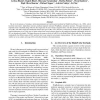Free Online Productivity Tools
i2Speak
i2Symbol
i2OCR
iTex2Img
iWeb2Print
iWeb2Shot
i2Type
iPdf2Split
iPdf2Merge
i2Bopomofo
i2Arabic
i2Style
i2Image
i2PDF
iLatex2Rtf
Sci2ools
LREC
2010
2010
Empty Categories in a Hindi Treebank
We are in the process of creating a multi-representational and multi-layered treebank for Hindi/Urdu (Palmer et al., 2009), which has three main layers: dependency structure, predicate-argument structure (PropBank), and phrase structure. This paper discusses an important issue in treebank design which is often neglected: the use of empty categories (ECs). All three levels of representation make use of ECs. We make a high-level distinction between two types of ECs, trace and silent, on the basis of whether they are postulated to mark displacement or not. Each type is further refined into several subtypes based on the underlying linguistic phenomena which the ECs are introduced to handle. This paper discusses the stages at which we add ECs to the Hindi/Urdu treebank and why. We investigate methodically the different types of ECs and their role in our syntactic and semantic representations. We also examine our decisions whether or not to coindex each type of ECs with other elements in th...
| Added | 29 Oct 2010 |
| Updated | 29 Oct 2010 |
| Type | Conference |
| Year | 2010 |
| Where | LREC |
| Authors | Archna Bhatia, Rajesh Bhatt, Bhuvana Narasimhan, Martha Palmer, Owen Rambow, Dipti Misra Sharma, Michael Tepper, Ashwini Vaidya, Fei Xia |
Comments (0)

